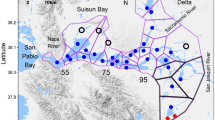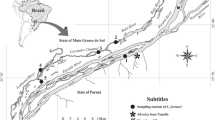Abstract
Settlement responses to boundary-layer flow of several invertebrate taxa, including the hydroid Tubularia crocea, the bryozoans Bugula turrita and Schizoporella unicornis, and the tube-building polychaete Hydroides dianthus were studied in manipulated field flows in Great Harbor, Massachusetts, USA. During three experiments in 1989 and two in 1990, densities of newly-recruited larvae were measured on flat plates, whose flow regimes had been manipulated by altering the leading-edge configurations. Settlement responses to flow were strongly species-specific, with T. crocea preferring regions of both high turbulence and strong shear stress, and S. unicornis settling a most exclusively in regions of high shear stress. B. turrita settled most prominently in regions of reduced shear stress, exhibiting settlement patterns that closely approximated predictions from a model of passive particle contact. H. dianthus showed a moderate avoidance of regions with high shear stress. These results indicate that boundary-layer flows affect settlement of several common encrusting species, a probable consequence of larval behaviors such as substrate rejection or exploration in response to flow. These responses are likely to generate patchiness during initial colonization of natural habitats, and certainly affect colonization of settlement panels commonly used in marine ecological studies.
Similar content being viewed by others
Literature cited
Agrawal, Y. C., Belting, C. H. (1988). Laser velocimetry for benthic sediment transport. Deep-Sea Res. 35: 1047–1067
Butman, C. A. (1987). Larval settlement of soft-sediment invertebrates: the spatial scales of pattern explained by active habitat selection and the emerging role of hydrodynamical processes. Oceanogr. mar. Biol. A. Rev. 25: 113–165
Butman, C. A., Chapman, R. J. (1989). The 17-meter flume at the Coastal Research Laboratory. Part I. Description and user's manual. Tech. Rep. Woods Hole oceanogr. Instn 89-10; 1–31
Butman, C. A., Grassle, J. P., Webb, C. M. (1988). Substrate choices made by marine larvae settling in still water and in flume flow. Nature, Lond. 333: 771–773
Crisp, D. J. (1955). The behavior of barnacle cyprids in relation to water movement over a surface. J exp. Biol. 32: 569–590
Crisp, D. J. (1981). Overview of research on marine invertebrate larvae, 1940–1980. In: Costlow, J. D., Tipper, R. C. (eds.) Marine biodeterioration: an interdisciplinary study. Naval Institute Press, Annapolis, Maryland, p. 103–126
Crisp, D. J., Barnes, H. (1954). The orientation and distribution of barnacles at settlement with particular reference to surface contour. J. Anim. Ecol. 23: 142–162
Eckman, J. E. (1990). A model of passive settlement by planktonic larvae onto bottoms of differing roughness. Limnol. Oceanogr. 35: 887–901
Eckman, J. E., Savidge, W. B., Gross, T. F. (1990). Relationship between duration of cyprid attachment and drag forces associated with detachment of Balanus amphitrite cyprids. Mar. Biol. 107: 111–118
Garland, E. D., Mullineaux, L. S. (1992). Particle contact on flat plates in flow: a model for initial larval contact. Tech. Rep. Woods Hole oceanogr. Instn 92-26: 1–27
Havenhand, J. N., Svane, I. (1991). Roles of hydrodynamics and larval behaviour in determining spatial aggregation in the tunicate Ciona intestinalis. Mar. Ecol. Prog. Ser. 68: 271–276
Jackson, J. B. C. (1977). Habitat area, colonization, and development of epibenthic community structure. In: Keegan, B. F., Ceidigh, P. O., Boaden, P. J. S. (eds.) Biology of benthic organisms. Pergamon Press, Oxford p. 349–358
Keen, S. L. (1987). Recruitment of Aurelia aurita (Cnidaria: Scyphozoa) larvae is position-dependent, and independent of conspecific density, within a settling surface. Mar. Ecol. Prog. Ser. 83: 151–160
Keough, M. J., Downes, B. J. (1982). Recruitment of marine invertebrates: the role of active larval choices and early mortality. Oecologia 54: 348–352
Kiya, M., Sasaki, K. (1983). Structure of a turbulent separation bubble. J. Fluid Mech. 137: 83–113
Miller, R. L., Albro, C. S., Cohen, J. M., O'Sullivan, J. F. (1972). A preliminary study of tidal erosion in Great Harbor at Woods Hole, Massachusetts. Tech. Rep. Woods Hole oceanogr. Instn 72-12
Mullineaux, L. S., Butman, C. A. (1990). Recruitment of benthic invertebrates in boundary-layer flows: a deep water experiment on Cross Seamount. Limnol. Oceanogr. 32: 409–423
Mullineaux, L. S., Butman, C. A. (1991). Initial contact, exploration and attachment of barnacle (Balanus amphitrite) cyprids settling in flow. Mar. Biol. 110: 93–103
Nowell, A. R. M., Jumars, P. A. (1984). Flow environments of aquatic benthos. A. Rev. Ecol. Syst. 15: 303–328
Osman, R. W. (1977). The establishment and development of a marine epifaunal community. Ecol. Monogr. 47: 37–63
Pawlik, J. R., Butman, C. A., Starczak, V. R. (1991). Hydrodynamic facilitation of gregarious settlement of a reef-building tube worm. Science, N.Y. 251: 421–424
Pyefinch, K. A., Downing, F. S. (1949). Notes on the general biology of Tubularia larynx Ellis and Solander. J. mar. biol. Ass. UK 28: 21–43
Redfield, A. C. (1953). Interference phenomenon in the tides of the Woods Hole region. J. mar. Res. 12: 121–139
Rittschof, D., Branscomb, E. S., Costlow, J. D. (1984). Settlement and behavior in relation to flow and surface in larval barnacles, Balanus amphitrite Darwin. J. exp. mar. Biol. Ecol. 82: 131–146
Roberts, D., Rittschof, D., Holm, E., Schmidt, A. R. (1991). Factors influencing initial larval settlement: temporal, spatial and surface molecular components. J. exp. mar. Biol. Ecol. 150: 203–211
Ruderich, R., Fernholz, H. H. (1986). An experimental investigation of a turbulent shear flow with separation, reverse flow, and reattachment. J. Fluid Mech. 163: 283–322
Scheltema, R. S., Williams, I. P., Shaw, M. A., Loudon, C. (1981). Gregarious settlement by the larvae of Hydroides dianthus (Polychaeta: Serpulidae). Mar. Ecol. Prog. Ser. 5: 69–74
Schlichting, H. (1979). Boundary-layer theory. 7th edn. McGraw-Hill, New York
Schoener, A., Schoener, T. W. (1981). The dynamics of the species-area relation in marine fouling systems: 1. Biological correlates of changes in the species-area slope. Am. Nat. 118: 339–360
Sokal, R. R., Rohlf, F. J. (1969). Biometry. The principles and practice of statistics in biological research. W. H. Freeman & Co., San Francisco
Sutherland, J. P. (1978). Functional roles of Schizoporella and Styela in the fouling community at Beaufort, North carolina. Ecology 59: 257–264
Walters, L. J. (1992). Field settlement locations of subtidal marine hard substrata: is active larval exploration involved? Limnol. Oceanogr. 37: 1101–1107
Wethey, D. (1986). Ranking of settlement cues by barnacle larvae: influence of surface contour. Bull. mar. Sci. 39: 393–400
Underwood, A. J., Fairweather, P. G. (1989). Supply-side ecology and benthic marine assemblages. Trends Ecol. Evol. 4: 16–20
Author information
Authors and Affiliations
Additional information
Communicated by N. Marcus, Tallahassee
Rights and permissions
About this article
Cite this article
Mullineaux, L.S., Garland, E.D. Larval recruitment in response to manipulated field flows. Marine Biology 116, 667–683 (1993). https://doi.org/10.1007/BF00355484
Received:
Accepted:
Issue Date:
DOI: https://doi.org/10.1007/BF00355484




